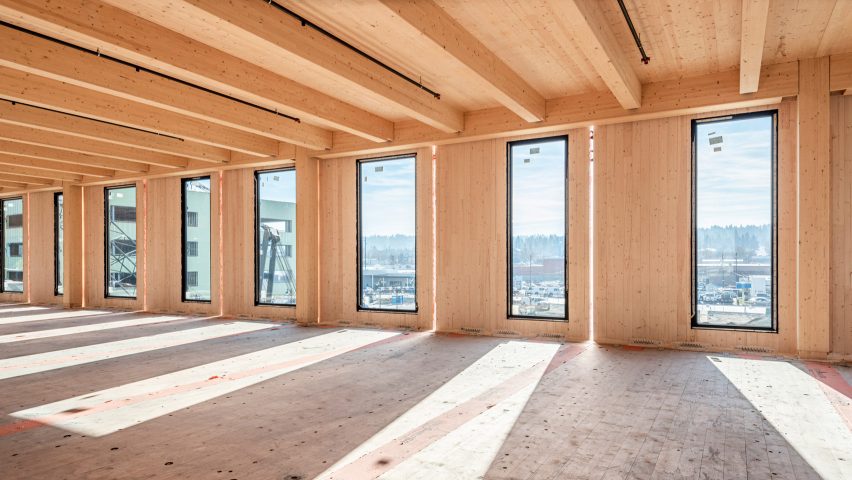Dezeen promotion: a newly published report on the cross-laminated timber supply chain demonstrates the material's sustainable credentials as it becomes more mainstream in the US.
Written by members of the Department of Architecture and School of Environmental and Forest Sciences at the University of Washington, the Life-Cycle Analysis (LCA) report investigates the environmental impact cross-laminated timber (CLT).
The authors of the report commissioned by construction company Katerra, carried out an in-depth environmental analysis of both Katerra's CLT factory and a building constructed from the material.
"The market needs mass timber to succeed"
CLT is a building material made up of alternating layers of sawn wood.
It is celebrated for having a lower embodied carbon footprint than traditional construction materials such as concrete and steel, because wood is renewable and low impact.
The LCA report seeks to verify the material's sustainable credentials, while also showcasing the material's ability to help deliver better quality buildings in terms of in-use performance and occupant wellbeing.
The company is championing striving to make CLT the US' leading building material.
"Green technologies are enhancing our ability to create more sustainable solutions that also meet structural and aesthetic demands," explained Nick Milestone, Katerra's director of mass timber.
"Mass timber, and CLT in particular, is the only material grown for construction that offers incredible biophilic design solutions," he told Dezeen.
"The market needs mass timber to succeed in order to meet ever-increasing housing and climate demands."
Study explores Katerra's first CLT building
A key study in the report was focused on the company's first building to make extensive use of its CLT system.
Named the Catalyst building, the five-story office was designed in partnership with Michael Green Architecture and uses CLT for almost its entire structure and building envelope.
The assessment found that the use of CLT nearly offset all of the building's upfront embodied carbon. According to Katerra, this means it is significantly lower than other North American commercial offices measured in other studies.
Another section of the report examined the company's own high-volume CLT factory in Spokane Valley, Washington, which demonstrates how the company is leading the way in bringing the material to the mainstream in the US.
Katerra's factory makes CLT products using timber sourced in sustainability-managed forests in Canada, and is capable of producing 140 boards per minute when at full operation.
Equivalent to 50, 23,000-square-metre, commercial office buildings a year, this is "more than any plant in the world" and means the company's CLT it produces has a smaller environmental footprint compared to other manufacturers in the US.
CLT embodies "Katerra's guiding principles"
Reflecting on the report, Katerra's product engineer Hans-Erik Blomgren concluded that "CLT has proven to be a versatile building block that allows for more efficient, factory-built, and sustainable approaches to design and construction".
He added: "Beyond its sustainability as a building material, CLT creates a new paradigm of sustainable systems. From sourcing to the factory to onsite logistics – it creates a new, more sustainable supply chain."
Find out more about the LCA results in the full report, or learn more about Katerra on its website.
Partnership content
This article was written by Dezeen for Katerra as part of a partnership. Find out more about Dezeen partnership content here.

